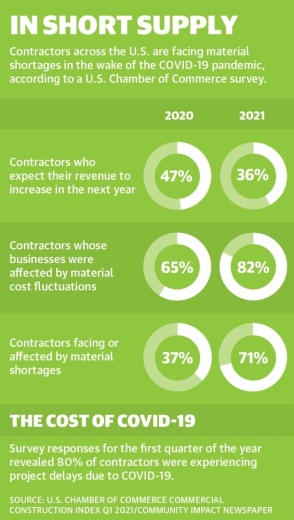Rising costs and a short supply of materials have caused construction delays locally and beyond, said Mike Dishberger, CEO of Houston-based Sandcastle Homes and former Greater Houston Builders Association president.
“People had nothing better to do [during the pandemic] than stay at home and decide they want to buy a new house or remodel,” he said. “So, demand has exceeded supply, and when that happens, prices rise.”
For example, Dishberger said plywood cost $7 per sheet in April 2020 and was up to $50 per sheet this June. A recent copper shortage increased the price of his electrical materials by 25%, he said.
Dishberger said he has seen costs go up in the past but never quite to this extent.
Realtor Janet Dziedzic, who has been a part of Spring-based The Matthews Team RE/MAX Legends for 17 years, said building materials, such as windows, tile and home appliances, are in short supply. While brick used to take six to 10 weeks to get delivered, Dziedzic said it is now taking anywhere from 16 to 20 weeks.
“Builders are getting frustrated because where it used to take them four months or so to build a home, it’s now taking more like five to seven months or even eight months,” Dziedzic said.
On top of rising costs of lumber and other materials, Dziedzic said increasing prices for laborers are also contributing to the problem.
As a result, Dziedzic said resale homes are becoming more attractive options for many potential homebuyers. However, low inventory is posing challenges on the resale side of the market.
“The buyers who were looking [for homes] under $200,000 are now competing with investors,” she said. “So these cash offers that are coming in over asking price are beating our first-time homebuyers who used to be able to get a home around $200,000.”
Dishberger said he expects to see elevated costs for several more months, and he does not anticipate costs ever declining to prepandemic levels.
“Until they get supply channels worked out where they have materials going across the country in rail, trucks, ship—however they get here—and get employees to work to do that, the issues are going to continue,” he said.





